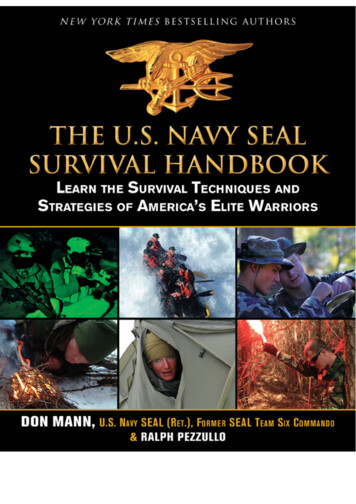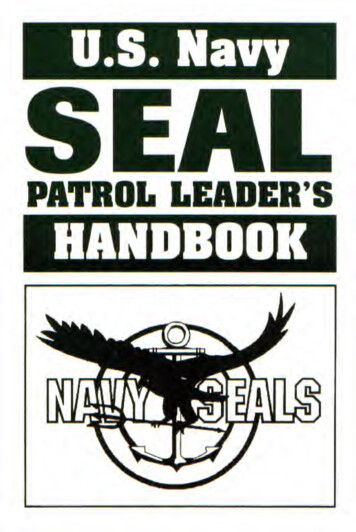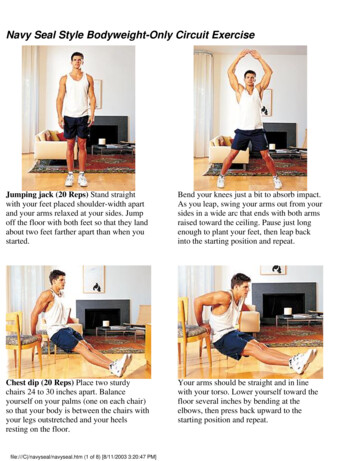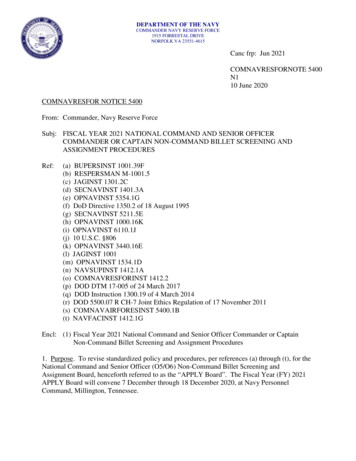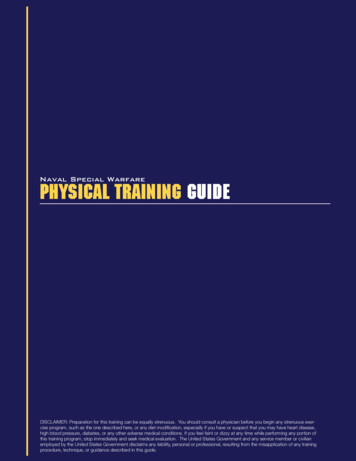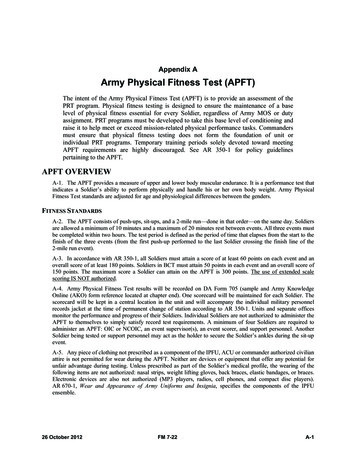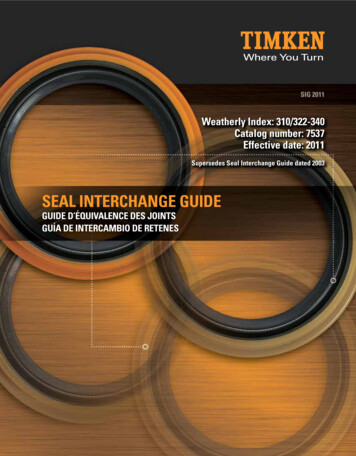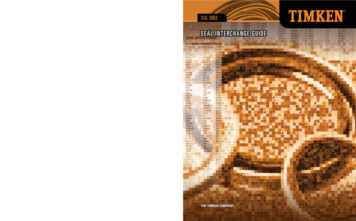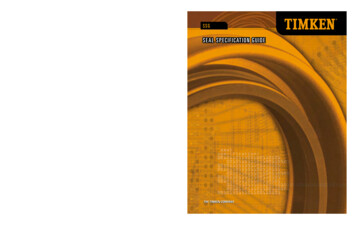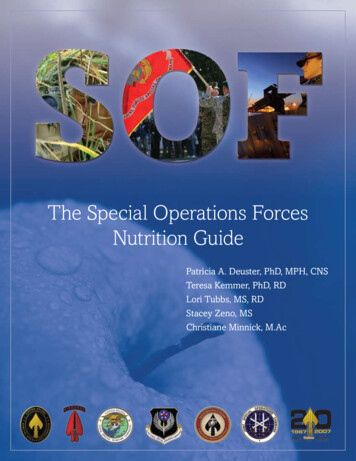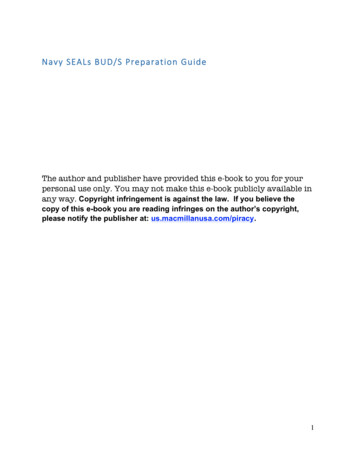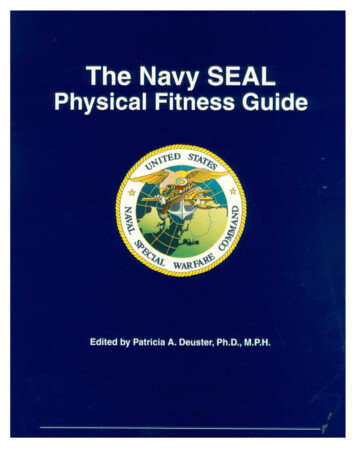
Transcription
The Navy SEAL PhysicalFitness GuideEdited by Patricia A. Deuster, Ph.D., M.P.H.Department of Military and Emergency MedicineUniformed Services University of the Health SciencesAugust 1997
AcknowledgmentsThe authors would like to recognize the invaluable contributions to thedevelopment of this guide by the following individuals. CAPT Kenneth Long participatedin both panel reviews and provided useful suggestions and comments. His meticulous workwas greatly appreciated by all. CAPT Peter Toennies reviewed and provided substantivecomments about the chapter “Swimming for Fitness”. Mr. Jeremy Levine and Ms. BrandiSchoeber provided information about strength training.Importantly, we were extremely fortunate to receive valuable input from severalSEALs throughout the development of this guide. ENS Frances Franky and BM1 GeorgeVernia participated in the first panel review and their suggestions were incorporated in thesecond draft of the manual. BM1 Vernia helped organize and participated in the second andfinal panel review. Other SEAL panel reviewers included CW03 John Shellnut, MasterChief Bob Bender, LCDR Pat Butler, and BMCS Duane Noel. Each one of these SEALsprovided suggestions and practical recommendations which were instrumental in thefinalization of the “The Navy SEAL Physical Fitness Guide”.The Navy SEAL Physical Fitness Guide
About the Authors, M.D.,CAPT Frank K. Butler, Jr.developed the chapter“SEAL Mission-Related Activities”. He is currently the Biomedical Research Director forthe Naval Special Warfare Command, Chairman of the U.S. Special Operations CommandBiomedical Initiatives Steering Committee, and a Staff Ophthalmologist at the NavalHospital, Pensacola, Florida. He obtained his undergraduate degree from Georgia Instituteof Technology in 1971, with high honors. His medical degree is from Medical College ofGeorgia, 1980. Dr. Butler’s Family Practice Internship was at the Navy Regional MedicalCenter, Jacksonville, Florida (1980-1981) and his Ophthalmology Residency was at theNational Naval Medical Center, Bethesda, MD. where he was Chief Resident (1988-1989).He completed his Undersea Medical Officer Training from the Undersea Medical Institute,Groton, Ct., 1981. CAPT Butler has been a platoon Commander for UnderwaterDemolition Team TWELVE and SEAL Team ONE, and a Diving Medical ResearchOfficer at the Navy Experimental Diving Unit. He has published extensively and been afrequent guest lecturer on the subject of closed-circuit diving and Special Warfare.CAPT John S. Hughes, M.D., developed the chapter “Swimmingfor Fitness” and contributed to “Other Training-Related Issues”. He is a Navy ReserveUndersea Medical Officer who resides near Littleton, Colorado. A graduate of theUniversity of Colorado School of Medicine, Dr. Hughes has a Naval Reserve assignmentto NAVSEA in Crystal City, Virginia, where he is assigned to the Supervisor of Diving andSalvage. Dr. Hughes has been involved with Navy diving medicine since 1981. He is BoardCertified in Occupational Medicine and his civilian medical practice in Colorado andWyoming involves operation of clinics and health facilities covering a wide range of highrisk industries including commercial diving.Special qualifications allow Dr. Hughes to participate in the development of theNavy SEAL Physical Fitness Guide. He swam freestyle in the NCAA Championships andwon the 1976 Big 8 Conference Championship in the 1650 yd freestyle for the Universityof Colorado and has remained active as a competitive swimmer. As a mountaineer andcross country skier he has organized and participated in numerous climbs, including two onThe Navy SEAL Physical Fitness Guide
Denali and Denali North Peak in Alaska. His instrumental work with the SEAL team indeveloping a winter warfare program during 1982 led him to participate as a staff memberof the SEAL winter warfare Greenland operation in 1983. For this involvement, Dr.Hughes received a letter of appreciation from the CO of SEAL Team TWO, CDR RickWoolard. With the theme of Dr. Hughes' career being medical support of high risk militaryand industrial operations, he feels that work for the SEALs is at the head of the list.CAPT Joseph Moore, M.D., developed the chapter “Training andSports-Related Injuries. He completed his undergraduatedegree in 1978, and medical degree in 1982 from the University of Virginia after which hewas commissioned as a Lieutenant in the Naval Medical Corps. CDR Moore completed hisinternship at Naval Medical Center,Oakland, California, in June 1983, and received orders to the 1st MarineDivision, Camp Pendleton, California. He served as Battalion Surgeon, 2nd Battalion, 9thMarines from July 1983 to October 1985, deploying to Okinawa, Korea and Panama. Healso served as 5th Marines Regimental Surgeon during this time period. He completed aFamily Practice residency at the Naval Hospital, Camp Pendleton in 1987, followed by atour as Senior Medical Officer on the island of La Maddalena, Italy. CDR Moore was thefirst Navy physician selected for a primary care Sports Medicine fellowship, and trained atthe San Diego Sports Medicine Center and San Diego State University from December1989 through January 1991.CDR Moore is currently the Department Head and Fellowship Director for theNavy's Sports Medicine program at the Naval Hospital and Marine Corps Base, CampPendleton. In addition to his duties as Specialty Leader to the Surgeon General, Dr. Mooreserves as chairman of the Sports Medicine Advisory Panel to the U.S. Naval SpecialWarfare Command, Coronado, and advisor to Marine Corps Combat DevelopmentCommand, Quantico. His work with the civilian community has earned him anappointment by the Governor of California to the Governor's Council on Physical Fitnessand Sports. He also holds an appointment to the United States Olympic Committee TeamPhysician Development Program, Colorado Springs, CO. He is co-chairman of theAmerican Academy of Family Physicians' Review Course for Sports Medicine.CDR Brad L. Bennett, Ph.D., developed the Chapter “LoadBearing” and he has written a technical report “Load Carriage: Are You PreparingCorrectly? Naval Medical Research Institute, Technical Memo 96-71, 1991”. He is aresearch physiologist currently assigned to the Department of Military and EmergencyMedicine, School of Medicine, Uniformed Services University of the Health Sciences,Bethesda, MD. He serves as an Assistant Professor and Director of the Basic SciencesDivision. He is a graduate of Wilderness Medicine, and Tactical Emergency MedicalTechnician courses, and is a department faculty member in the Counter Narcotics TacticalOperations Medical Support (CONTOMS) course as sponsored by the Department ofDefense. He earned a Bachelor and Master Degrees in Exercise Science from San DiegoState University and a Ph.D. in Kinesiology from the University of Maryland.He has completed the Navy's diving medicine course and became designated as aNavy Medical Department Deep Sea Diving Officer. He has conducted biomedicalresearch on the impact of environmental stressors on human performance of Navy SpecialAbout the Authors
Warfare (SEAL) personnel, U.S. Marine Corps personnel, and Navy damage controlpersonnel. Dr. Bennett currently serves as the Special Advisor to Navy Surgeon Generalfor Physiology.Dr. Bennett has enjoyed long distance running (10k, half marathons and marathons)for over twenty years. Other hobbies of interest are hiking, kayaking, camping, weighttraining, target and skeet shooting.LCDR Lisa Thorson, M.D., wrote the Chapters on Flexibility, Calisthen-ics and Plyometrics. She earned her B.S. in psychology at the University of Oklahoma inNorman, Oklahoma, and her M.D. from the University of Oklahoma School of Medicine.She has completed the Undersea Medical Officer course and had a tour of duty at theDiver Second Class Training Department, Naval Amphibious School, Naval AmphibiousBase, Coronado. LCDR Thorson has been involved with the Exercise-Related Injury Program, and all aspects of injury prevention for the Special Operations Community. Projectshave included the development of injury tracking software used by the Special Operationscommunity. She also organized the first Naval Special Warfare Spots Medicine conferenceheld May 1994. Recommendations from this conference are documented in Naval HealthResearch Center Technical Document Number 95-4D, “Naval Special Warfare SportsMedicine Conference Proceedings,” and Number 95-5D, “Expert Panel Review of theNaval Special Warfare Calisthenics Sports Medicine Conference Summary.”Currently she is in Residency training in Preventive Medicine at the UniformedServices University of the Health Sciences, Bethesda, Maryland, where her workdocumenting injuries in the Special Operations community will continue. She has 13 yearsof ballet training, has taught and competed in aerobic dance competitions, and spends hertime weight-training.Patricia Deuster, Ph.D., M.P.H., the editor of this guide, wrote“Cardio-respiratory Conditioning” and “Strength Training” and contributed to “OtherTraining-Related Issues”. She compiled the group’srecommendations and wrote the chapter “Physical Fitness and TrainingRecommendations”. She is an Associate Professor and Director of the Human PerformanceLaboratory in the Department of Military and Emergency Medicine at the UniformedServices University of the Health Sciences, School of Medicine in Bethesda, Maryland.She has an undergraduate degree in Mathematics, and graduate degrees in PhysicalEducation (M.A.), Nutritional Sciences (Ph.D.), and Public Health (M.P.H.). Hercredentials for editing this book are many. She has been conducting research in the area ofsports nutrition and exercise physiology for over 14 years. Dr. Deuster has publishednumerous papers on the nutritional needs of U.S. Navy SEALs, and has given many sportsnutrition seminars to high school, college, and professional athletes, recreational athletes,SWAT teams, dietitians, and other health professionals. She is also an athlete herself. Shewas a tennis professional for five years and has competed in several triathlons and over 20marathons; her best marathon time was a 2:48 in the Boston Marathon. Dr. Deuster was anationally ranked runner for several years and a qualifier for the First Women’s OlympicMarathon Trials. She is an avid sportswoman and a former skydiver who has logged in over100 jumps.The Navy SEAL Physical Fitness Guide
Anita Singh, Ph.D., wrote “Overview of Physical Fitness” and “Runningfor Fitness” and assisted Dr. Deuster with the editing of this guide. She is an AssistantProfessor in the Department of Military and Emergency Medicine at the UniformedServices University of the Health Sciences, Bethesda, Maryland. Dr. Singh has a Ph.D. inNutrition from the University of Maryland, and she has been working in the area of SportsNutrition and Exercise Physiology for over 10 years. In addition to looking at nutritionalneeds of U.S. Navy SEAL trainees, she has studied marathoners, ultramarathoners, andrecreational athletes. She has presented her research work at various national andinternational meetings. Dr. Singh has published extensively in scientific journals and sheco-authored “The Navy SEAL Nutrition Guide”. She runs and plays tennis.CDR Kevin C. Walters, M.D., developed the chapter “Trainingfor Specific Environments”. He is a Diving Medical Officer at the Naval Special WarfareCenter in Coronado, CA. Dr. Walters enlisted in the Navy in 1974, and graduated fromBUD/S in 1976 (class 87) and served five and a half years at SEAL Team ONE. He leftactive duty in 1983 to return to college and graduate school. He received his M.D. degreein 1993 from the Uniformed Services University of the Health and subsequently completeda Transitional Internship at the Naval Medical Center, San Diego, CA.CAPT Steve Giebner, M.D., contributed to the chapter “HarmfulSubstances that Affect Performance”. He is currently the Force Medical Officer forCommander, Naval Special Warfare Command. His association with the Naval SpecialWarfare community goes back to 1982 when he took his first operational assignment as theDiving Medical Officer for the Naval Special Warfare Training Department of the NavalAmphibious School, Coronado. He is also plank owner at Naval Special Warfare Center asthe first Medical Officer assigned to that command.Dr. Giebner specialized in Sport and Exercise Preventive Medicine and HealthPromotion, having earned the Master of Public Health degree in the Preventive Medicineresidency at the University of California at San Diego and San Diego State University. Hehas long been an active proponent of Sports Medicine in the Navy, and especially withinNaval Special Warfare His long association with Navy SEALs and his professional traininguniquely qualify him to contribute to this manual.In addition to recreational tennis, golf, and in-line skating, Dr. Giebner hasconsistently participated in command endorsed physical training programs throughout hisNaval career. This year marks his first entry in the San Diego Marathon and a SuperfrogTriathlon relay team.HMC Denise E. Becker, USNR, developed “Appendix A -Weight Lifting Techniques” and assisted in the editing of this guide. She has a B.S. inOccupational Education and is pursuing a Masters degree in Exercise Physiology. She hasserved as the Training Chief and is currently assigned to Assault Craft Unit-4 Det 1 asDivision Officer and the Medical Department Representative. An avid sportswoman, shehas participated in several half marathons, 10 and 5K races, and triathlons. She competedin the Tidewater All-Navy Tennis Tournament. Chief Becker is married to a SEAL, AlBecker, LCDR, USN-RET and they have five children. The whole family has participatedin the UDT/ SEAL Reunion Family Fun Run the past 10 years.About the Authors
An Introduction byRADM Raymond C. SmithMembership in the Naval Special Warfare (NSW) community requires anextraordinarily high level of total body physical fitness. A combination of muscularstrength, flexibility and cardiovascular fitness is essential to carry out assigned missions.To train most effectively for these physically demanding tasks, SEALs and otherswithin the NSW community need clear, concise, and authoritative guidance on physicalfitness training regimens. This manual, The Naval Special Warfare Physical FitnessGuide, has been written to meet this need.The authors of this comprehensive guide, physicians and physiologists, werechosen because of their special qualifications in the area of physical fitness and theirknowledge of the NSW and SEAL community. Their expertise ensured the guide would bewritten with the unique requirements of the NSW community in mind, and that our goal ofexpanding the individual Navy SEAL's knowledge of attaining and retaining a high levelof fitness would be achieved.I commend The Naval Special Warfare Physical Fitness Guide as a superb sourceof information. Following the advice in this guide will enable SEALs and other membersof the NSW community to prepare for the physically demanding missions to which they areassigned in the future.The Naval Special Warfare Physical Fitness Guidei
ii
Table of ContentsAn Introduction by RADM Raymond C. SmithiList of TablesxiList of FiguresxvIntroductionChapter 11Overview of Physical Fitness3Exercise Physiology3Definitions and TerminologyMuscle Structure and Function37Type I Muscle Fibers8Type II Muscle Fibers8Distribution of Fiber Types9Principles of Physical Training10Overload10Specificity of Training11Individual Differences11Detraining11Determining Your Training Heart Rate12Energy Systems Used by Exercising Muscle14ATP-CP System for Speed Work14Lactic Acid and ATP-CP System for Anaerobic Work15Oxygen System for Aerobic Energy15Methods of Physical Training16Interval Training17Sprint Training18Interval Sprints18Acceleration Sprints18Fartlek or Speed Play18Continuous Exercise Training18Repetition Running19Conditioning and Deconditioning19Active Recovery20The Navy SEAL Physical Fitness Guideiii
Chapter 2Chapter 3SEAL Mission-Related Physical Activities21Mission-Specific Activities22Small Unit Patrolling22High Speed Boat Operations23Combat Swimmer Operations24SDV and Dry Deck Shelter Operations25Urban Warfare25Winter Warfare Operations26Specific Mission-Related Physical Tasks26Summary30Cardiorespiratory Conditioning31Basics Concepts of Cardiorespiratory Exercise32Terms Related to Conditioning33Determination of Work Rate34Factors Affecting the Training Response35Active Recovery36How to Estimate Your Maximal Aerobic Capacity37Bicycle Exercise Test Instructions37Test Procedures37Estimating Maximal Aerobic Capacity38Types of Aerobic Activities and Basic WorkoutsOutdoor Activities41Stationary Exercise Alternatives43Basic Workouts49Other Terms for Work RateMETs and WattsChapter 4iv414951Summary52Running for Fitness53Running Gear54Running Shoes54Clothes60Other Gear Items60Running Surfaces61Warm-Up63Cool-Down and Stretching63
Running Gait or FormFootstrike64Forward Stride64Body Angle64Arm Drive64Building Your MileageChapter 56365Running Frequency65Running Speed and Intensity65Training for a Marathon67Interval Training68Varying Your Workouts69Common Running Injuries or Problems69Resources70Swimming for Fitness71Open Water Gear72Wet Suits72Hood, Gloves and Booties72Fins and Fin Selection73Face Masks76Open Water Training76Water Temperature Issues77Special Open Water Training Issues78Swimming Pool Gear79Goggles79Kickboard79Pullbuoy79Hand Paddles80Zoomers80Nose Clips80Pool Training: Building Strength and Endurance80Warming Up81Basic Principles of Interval Training81Interval Sets - Endurance83Interval Sets - Strength and Power84Integrated Workouts84The Navy SEAL Physical Fitness Guidev
Underwater Training86Varying Your Workout86Developing Stroke SkillsChapter 6Chapter 7General Stroke Principles87The Strokes88Swimming Drills91Common Problems92Strength Training93Weight Training Gear and Equipment93Strength Training Guidelines and Terms94Repetition Maximum or RM95FITT: Frequency, Intensity, Time, Type95Muscle Balance and Exercise Selection List97Determining Repetition Maximums98Periodization100Weight Lifting Techniques103Types of Workouts103Warming Up105Cooling Down and Stretching106Common 107Flexibility109Flexibility Benefits109Definition110The Stretch Reflex and the Lengthening Reaction111Flexibility Training Methods112Dynamic Stretching113Static Stretching113Ballistic Stretching113PNF Stretching114Warming-Up and StretchingGeneral Warm-Upvi87115116
Activity-Specific Warm-UpRecommended StretchesChapter 8Chapter 9Chapter 10116118Dynamic Stretching118Static Stretching122A Post-Exercise Total Body Stretching Program130Resources131Calisthenics133The Muscle Strength-Endurance Continuum133Calisthenics in Naval Special Warfare135Balancing Abs and Hip Flexors and Extensors137Recommendations for Sit-Ups140Recommendations for Calisthenics142Calisthenic Exercises143Modified Calisthenic Exercises153Resources158Plyometrics159How Plyometrics Work160Preparation for Plyometric Training161Safety in Plyometric Training161Program Design and the Overload Principle162Plyometric Training166Plyometric Exercises166Eccentric Downhill l and Environmental Factors176Body and Load Weight176Biomechanics of Load-Bearing177Load-Bearing and Walking Pace177Hydration Status179Environmental Stress179Sleep Loss180Protective Clothing180Physical Training for Load- Bearing180The Navy SEAL Physical Fitness Guidevii
Chapter 11Elements of a Load-Bearing Conditioning Program180Initiating Load Training181Maintaining Load-Bearing Fitness182Optimizing Load-Bearing182Common Medical ng for Specific Environments185Training in Hot Environments186Factors that Hinder Body Cooling in the Heat186Heat Acclimation187Heat Injuries188Summary for Hot Environments190Training in Cold EnvironmentsFactors that Compromise Adaptations to Cold191Acclimation to the Cold191Cold Injuries192Nutritional Requirements193Summary for a Cold Environment194Training at AltitudeChapter 12194Acute Mountain Sickness195Other Factors that Hinder Performance at Altitude195Acclimation to Altitude196Training in Confined Spaces196Deconditioning198Training and Sports Related Injuries199Treatments for Training-Related Injuries200Reduce Inflammation200Application of Ice201Range of Motion202Non-Steroidal Anti-Inflammatory Drugs (NSAIDs)203Reconditioning for Return to Full Activity205Return to Mission-Related Tasks206General Guidelines for Returning to Physical Activity206Types of Injuriesviii190207
Training-Related Muscle Soreness207Contusions207Sprains and Strains208Muscle Cramps208Fractures209Common Mission and Training Related InjuriesChapter 13Swimming213Running and Hiking214Knee Sprains214Ankle Sprains215Overtraining Syndrome215When to Seek Medical Care217Harmful Substances that Affect Performance221Anabolic/Androgenic Steroids221How do Anabolic Steroids Work?222How Anabolic Steroids Alter Metabolism224Purported Beneficial Effects of Anabolic Steroids224Adverse Effects of Anabolic Steroids225Legalities of Steroid Use227Medical Uses of Corticosteroids227Other Harmful ChemicalsChapter 14211227Growth n231DHEA232Summary233Resources233Other Training-Related Issues235Winter Warfare Training235Training for Skiing236Turns, Stops, and Technique236The High Mileage SEAL237Nutritional Ergogenic Agents241Nutritional Products Advertised as Ergogenic AgentsThe Navy SEAL Physical Fitness Guide241ix
Summary of Ergogenic Agents244Protein-Carbohydrate Supplements245Resource246Physical Fitness and Training Recommendations247The SEAL Physical Fitness Program247A Physical Fitness Program for Confined Spaces253A Physical Fitness Program for Coming Off Travel254Elimination of “Old” Exercises256A Short Flexibility Program257The Navy SEAL Physical Readiness Test (PRT)258Final Comments From: RADM Smith260Summary263Appendix A.Weight Lifting Techniques265Appendix B.Common Anatomical Terms and Diagrams275Appendix C.Foot Care for Load-Bearing281Chapter 15x
List of TablesTable I-1.Skill- and Health-Related Components of Physical Fitness2Table 1-1.Distinguishing Characteristics of Major Muscle Fiber Types9Table 1-2.Percentage Contributed by Each Energy System to OverallEnergy Needs of Various Activities16Table 1-3.Contribution of the Various Energy Systems According toTraining Methods17Table 1-4.Various Effects of Physical Conditioning19Table 2-1.A Summary of Various SEAL Missions22Table 2-2.Physical Requirements for Specific Missions and Mission Elements28Table 2-3.Specific Physical Task-Related Training29Table 3-1.Example of the Relation Between Exercise Intensity, AerobicCapacity and Heart Rate35Table 3-2.Stages and Work Rates for Cycle Ergometer Exercise Testing38Table 3-3.Cycle Ergometer Test Form38Table 3-4.Cardiorespiratory Fitness Classification: Maximal OxygenUptake (ml/kg/min)39Table 3-5.Typical Energy Requirements for Various Outdoor Activities41Table 3-6.Different Types of Jumps for Jumping Rope43Table 3-7.Various Workouts for a Rowing Machine44Table 3-8.Energy Expenditure (kcal/hr) for Stationary Cycling atVarious Intensities and Body Weights45Table 3-9.Approximate Energy Requirements (kcal/hr) for Horizontaland Uphill Running on a Treadmill46Table 3-10.Energy Expenditure (kcal/hr) on a Ski Machine at VariousSettings and Speeds47Table 3-11.Energy Expended (kcal/hr) during Stair Stepping at VariousStep Rates48Table 3-12.Energy Expended (kcal/hr) on a Climber at DesignatedWeights and Feet per Minute48The Navy SEAL Physical Fitness Guidexiii
Table 3-13.Workload Conversion Sheet51Table 4-1.The Right Shoe for Your Foot Type59Table 4-2.Running Surfaces: From Best to Worst61Table 4-3.A Program to Run 40 Miles per Week66Table 4-4.A 12 Week Marathon Training Program Starting at 40 Miles/Week67Table 4-5.Frequency of Running Injuries Reported by a Sampleof Male Runners70Table 4-6.Three “Principles” of Good Running Form70Table 5-1.Recommended Fin Types74Table 5-2.Distance, Temperature, and Protection Requirements78Table 6-1.Free Weight and Exercise Machine Comparison94Table 6-2.Exercise Selection List by Body Part97Table 6-3.How to Determine Your 5RM for a Bench Press99Table 6-4.Intensity Levels Relative to a 1RM100Table 6-5.An Annual Plan for Activation, Strength Development andMuscular Endurance101Table 6-6.Strength Development Phase: 2-Day Circuit WeightTraining Routine102Table 6-7.Muscle Endurance Phase: A 2-Day Circuit Weight Training Routine102Table 6-8.Week 1: Circuit Training Strength Development Phase104Table 6-9.Week 1: Circuit Training Muscle Endurance Phase104Table 7-1.Dynamic Stretch Exercises to be Used in Physical Training119Table 7-2.Static Stretch Exercises to be Used in Physical Training123Table 8-1.The Strength-Endurance Continuum134Table 8-2.Recommended Calisthenics for Physical Training143Table 8-3.Tips for Developing a Buddy-Assisted Exercise Program154Table 8-4.Buddy Exercise Drills155Table 9-1.A 10-Week Plyometric Program164Table 9-2.Plyometrics: Classified by Jump Direction and Intensity165xiv
Table 9-3.Plyometric Exercises167Table 9-4.Upper Body Plyometrics171Table 10-1.Optimizing Load Carriage182Table 11-1.Warning Signs of Heat Stroke189Table 11-2.Drugs and Chemicals to be Avoided in Hot Environments189Table 12-1.Tips for Applying Ice: Passive and Active202Table 12-2.Generic Names (and Common Names) for VariousNon-Steroidal Anti-Inflammatory Agents204Table 12-3.A Process of Alleviating Muscle Soreness207Table 12-4.Return to Running Post Injury211Table 12-5.Musculoskeletal Injuries Associated with Mission-Elements212Table 12-6.Common Running Injuries214Table 12-7.Characterization and Symptoms of Overtraining Syndrome216Table 12-8.Symptoms, Prevention, and Treatment of CommonTraining- and Mission-Related Injuries218Table 13-1.Commonly Used Anabolic/Androgenic Steroids223Table 13-2.Adverse Effects of Anabolic Steroids in Men: Physiologicand Psychological226Table 13-3.Physiologic Effects of Growth Hormone228Table 13-4.Reported Physiologic Effects of Amphetamines229Table 13-5.Psychological Effects of Amphetamines230Table 13-6.Adverse Effects of Amphetamine Use231Table 14-1.Sites, Common Causes of, and Recommendations forChronic Musculoskeletal Pain238Table 14-2.Physical Fitness Program for High Mileage SEALs withChronic Musculoskeletal Pain239Table 14-3.A PT Program for High Mileage SEALs with ChronicMusculoskeletal Pain240Table 14-4.Nutritional Ergogenic Agents242Table 15-1.The Navy SEAL Physical Fitness Program248The Navy SEAL Physical Fitness Guidexiii
Table 15-2.Alternate Activities for a Fitness Program249Table 15-3.Basic Physical Training (PT) Activities for Warm-Up,Flexibility and Strength249Table 15-4.Total Body Physical Training (PT) Activities for Warm-Up,Flexibility and Strength251Table 15-5.Physical Fitness in Confined Spaces253Table 15-6.A Re-Entry Physical Fitness Program254Table 15-7.Re-Entry Physical Training255Table 15-8.Exercises Eliminated from SEAL PT257Table 15-9.Selected Stretching Exercises for Improving Flexibility A Short Program258Table 15-10.PRT Score for a 34 year old SEAL259Table 15-11.RADM Smith’s PT Program261Table 15-12.Examples of RADM Smith’s Exercises262xiv
List of FiguresFigure 1-1.Muscle Fiber Composition and Maximal Oxygen UptakeValues for Various Athletes by Sport10Figure 1-2.An Example for Determining Your Target Training Heart Rate13Figure 1-3.Target Training Heart Rate Zone13Figure 1-4.An Example for Determining Your Target Training HeartRate for Swimming14Figure 3-1.Plot Your Heart Rate to Estimate Maximal Oxygen Uptake40Figure 4-1.Parts of a Running Shoe55Figure 4-2.Types of Lasts Used for Running Shoes56Figure 4-3.Shoe Construction: Lasting57Figure 4-4.Types of Arches57Figure 4-5.Ways to Increase Running Speed66Figure 4-6.Sample Sprint and Distance Running Interval Workouts68Figure 5-1.Examples of Traditional Short and Long Fins (Left) and NewerLong Blade Fins with Innovative Buckles (Right)74Figure 5-2.Energy Systems Used During Interval Sets82Figure 5-3.Sample Anaerobic and Aerobic/Endurance Swim Interval Workouts85Figure 5-4.Comparing the Free-Style Stroke to the Blades Turningon a Propeller88Figure 5-5.The Free-Style Stroke of Mark Spitz88Figure 5-6.Below the Swimmer View of Mark Spitz’s Free-Style Stroke89Figure 5-7.Side and Front Views of Mark Spitz’s Free-Style Stroke90Figure 6-1.Applying the FITT Principle to Total Body Circuit Weight Training96Figure 6-2.Determining Your 1RM from 5RM99Figure 7-1.Graphical Representations of Muscle Spindles andGolgi Tendon Organs111Figure 7-2.Contract-Relax PNF Technique115Figure 7-3.Specific Warming-Up Activities117The Navy SEAL Physical Fitness Guidexv
Figure 7-4.Recommended Exercise Sequence118Figure 7-5.Total Body Post-Exercise Stretching Program131Figure 8-1.Modified Flutterkick: Keeping One Foot on the DeckProtects the Lower Back139Figure 8-2.Modified “Knee Bender”: Keeping One Foot on the DeckProtects the Lower Back139Figure 8-3.Range of Motion for Flexion and Extension of the UpperBody Based on Anatomy139Figure 8-4.Placing a Towel Beneath the Lower Spine can Help Achievethe Right Form for Abdominal Exercises140Figure 8-5.Proper Technique for Sit-ups: Legs Slightly Turned Outwardand Elbows Behind Neck at All Times140Figure 8-6.Variations on Sit-Up Routines141Figure 9-1.Three Phases of Plyometrics: Lengthening, Amortization andTake-Off160Figure 10-1.Workload and Energy Expenditure During Load-Bearing178Figure 10-2.Effects of Walking Pace by Pack Weight and Terrain178Figure 12-1.Moving the Ankle Through its Range of Motion (ROM)with Resistance203Figure 12-2.Technique of Cross-Friction Massage208Figure 12-3.Examples for Treating Painful Muscle Cramps in the Calf andQuadricep Muscles209Figure B-1.Selected Muscles of
The Navy SEAL Physical Fitness Guide. Anita Singh, Ph.D., wrote “Overview of Physical Fitness” and “Running for Fitness” and assisted Dr. Deuster with the editing of this guide. She is an Assistant Professor in the Depar
